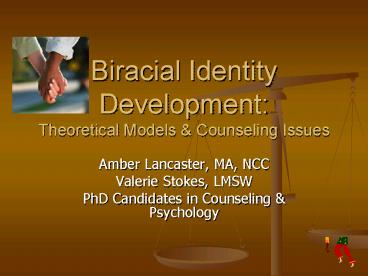Biracial Identity Development: Theoretical Models PowerPoint PPT Presentation
1 / 23
Title: Biracial Identity Development: Theoretical Models
1
Biracial Identity DevelopmentTheoretical Models
Counseling Issues
- Amber Lancaster, MA, NCC
- Valerie Stokes, LMSW
- PhD Candidates in Counseling Psychology
2
Definition of Terms
- Biracial
- Biological race blend of African-American and
Caucasian genetics - Society defines race in a rigid dichotomous
fashion
3
SocioCultural History
- 1967 Supreme Court decision Loving vs. Virginia
- Legacy of Slavery
- One drop rule
- Multiracial Category
- 1997 US Office of Budget and Management
- Trend increase of interracial marriages and
partnerships
4
Effects of Physical Characteristics
- Passing
- Predisposition to being considered different
and acts of racism - Stereotypical Culture based on Appearance
5
Biracial Youth Unique Experiences
- Integration of dual racial and cultural
identities with development of positive
self-concept (Gibbs, 1989). - Mixed race identity issues can effect and
complicate developmental conflicts - Social Acceptance
- Sense of Belonging
- Peer group relationships
- Dating
- Potential at-risk behaviors
6
Parental Awareness
- Racism messages
- Overt
- Covert
- Impact of media, school systems, communities
- Teach coping strategies
7
Original Models of Identity Development
- Stonequest (1937) Marginal Person Model
- Cross (1978) African-American Identity Model
- Morten Atkinson (1983) Ethnic Minority
Identity Model - Gibbs (1989) Deficit Model of Biracial
Development Model
8
Limitation of Models
- Implications
- Monoracial focus
- Deficit focus
9
Rationale for New Models
- Contributing factors.
- Sociopolitical influence
- Psychological conflicts
- Assessment Diagnosis
- Tools for Understanding Differences
- Conceptual framework
10
Biracial Identity Development Models
- Poston (1990)
- Root (1990)
- Smith (1991)
- Jacobs (1992)
- LaFromboise et al (1993)
- Kerwin Ponterro (1995)
- Helms (1995)
11
Biracial Identity Development Model
- Poston (1990) stage theory of biracial identity
development - 1. Personal Identity
- 2. Choice of Group Categorization
- 3. Enmeshment/Denial
- 4. Appreciation
- 5. Integration
- Value of multiple cultures lead to fullness.
12
Biracial Identity Development Model
- Root (1990)
- 4 Path Model
- Choosing the identity assigned by others
- Identifying with both racial groups
- Choosing one racial group over the others
- Identifying with a new, biracial or multiracial
group - All paths lead to positive sense of biracial
self.
13
Biracial Identity Development Model
- LaFromboise, Coleman and Gerton (1993)
- Model of bicultural competence
- Assimilation
- Acculturation
- Alternation
- Multicultural
- Fusion
- Propose that individual can live in two cultures
without negative effects
14
Biracial Identity Development Model
- Smith (1993)
- Ethnic identity conflicts
- Overt conflicts create boundary lines
- Phase 1
- Phase 2
- Phase 3
- Phase 4
15
Biracial Identity Development Model
- Kerwin Ponterotto (1995)
- Empirically based developmental 7 stage model
- Preschool age
- Entry to school
- Preadolescence
- Adolescence
- College/Young Adulthood
16
Conclusions of Models
- No singular way Black-White mixed race people
understand their racial identity. - No one model
- Fail to comprehend the multidimensionality and
complexity of mixed race identity. - SocioCultural Context
- Validation
17
Counseling Approaches
- Awareness
- Counselor
- Own personal bias
- Client
- Acknowledge societal/environmental impact of
biracialism - Aware of prejudices and injustices
- Advantages/disadvantages
- Techniques
- Family Trees, bibliotherapy, role play, support
groups
18
Counseling Approaches
- Communication
- Counselor
- Address the topic of biracial/ethnic issues
- Develop a comfort level
- Client
- Discuss biracial identity
- Experience validation
- Techniques
- Art therapy, narrative therapy
19
Counseling Approaches
- Exposure
- Counselor
- Be willing to attend cultural events
- Openness to new ideas, cultures, etc.
- Client
- Explore all aspects of their heritage
- Embrace their identity
- Find positive ways to respond to discrimination
- Techniques
- Experiential learning, support groups
20
Counseling StrategiesA Relational-Narrative
Therapeutic Approach
- Invite clients to tell their stories.
- Externalizing the problem.
- Probing for unique outcomes and subjugated
stories. - Expressing curiosity.
- Re-authoring ones life.
- Expanding the therapeutic conversation.
- Telling the new story to an audience.
- Strengthening self-validation.
- Developing strategies of resistance.
- (Rockquemore Laszloffy, 2003)
21
Case ExampleMr. Y
- Break out into small groups, discuss case study,
answer following questions - What strengths and deficits can you identify in
the case study? - If Mr. Y, came to your office, how might you work
with him? - How would you potential biracial identity issues
with this client?
22
Thank you for your participation!
- Amber Valerie
23
References
- Aldarondo, F. (2001). Racial and ethnic
identity models and their application
Counseling biracial individuals. Journal of
Mental Health Counseling, Vol. 23(3), pp 238-255. - Herring, D. (1995). Developing biracial ethnic
identity A review of the increasing dilemma.
Journal of Multicultural Counseling
Development, Vol. 23(1), p.29. - Kenney, K. (1999). Multiracial Families in
chapter 6 of Advocacy in Counseling Counselors,
Clients Community. Counseling and Student
Services Clearinghouse. - Rockquemore, K and Laszloffy, T. (2003).
Multiple realities A relational narrative
approach in therapy with black-white mixed-race
clients. Family Relations, Vol. 52(2),
p.119-129. - http//www.nasponline.org/publications/cq327multir
acial.html - http//www.ameasite.org/census/

